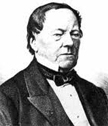(Pehr) Georg Scheutz
Born September 23, 1785, Jönköping, Sweden, died May 22, 1873, Stockholm, Sweden; father in the Swedish father-and-son team who in 1853 constructed the world's first commercially available, operational Difference Engine after the style of Charles Babbage.

Education: law degree, University of Lund, 1805.
Professional Experience: probationer, Göta Hovratt, 1805-1811; Justitie-Revisionen för Sjöärendena, 1811; deputy actuary, Jönköping, 1812; second auditor, Svea Artillery Regiment, 1812-1816; owner/editor, Anmeirkaren (newspaper), Stockholm, Sweden, 1816-1836.
Honors and Awards: Medaille d'Honneur, L'Exposition Universelle de Paris, 1855; Swedish Order of Wasa, 1856; Russian Order of St. Anne, 1858.
Georg Scheutz originally had ideas about becoming a mining engineer, but his university did not have the courses necessary to fulfill the requirements, and thus he graduated with a degree in law. He practiced law in various capacities for about 11 years, when his finances, buoyed by inheritances, were sufficient for him to set himself up in business as a newspaper publisher. In 1834 Georg Scheutz published a small book containing an invention which was an improvement on Napier's "bones." In the same year Scheutz learned the details of Babbage's work on the Difference Engine through the publication of Dionysius Lardner. [Lardner, Dionysius, "Babbage's Calculating Engine," Edinburgh Review, No. 120, July 1834.] Scheutz began to experiment with models of wood, pasteboard, and wire, and soon developed some improvements with the assistance and ingenuity of his son Edvard, then a teenager. By 1842 they had built a calculating unit which was capable of third order differences; they completed their first engine in 1843, including the printing unit. With funding from the Swedish Academy of Sciences, a second Difference Engine was built according to the Scheutz' plans by Johan Bergström in 1853; it was sold to the Dudley Observatory in New York in 1857.
A copy of this engine was ordered by the General Register Office in London. Built by Bryan Donkin and Co., this machine was delivered in 1859 and was put to work to produce life-time tables. The Scheutzes and Babbage met for the first time in late 1854, by which time Babbage was deeply involved in his design of the Analytical Engine, his Difference Engine never having been completed. Babbage, however, undertook to publicize the Scheutz machines, designating his son Prevost to develop a notation for describing their second engine.
Although well known for 30 years, the "difference engine business" did not bring the Scheutz family the expected financial returns. Georg died virtually bankrupt in 1873. [Reviewed and corrected by Michael Lindgren, National Museum of Science and Technology, Stockholm.]
BIBLIOGRAPHY
Biographical
Chase, George C., "History of Mechanical Computing Machinery," Ann. Hist. Comp., Vol. 2, No. 3, 1980, pp. 198-226.
Lindgren, Michael, Glory and Failure: The Difference Engines of Johann Müller, Charles Babbage, and Georg and Edvard Scheutz, MIT Press, Cambridge, Mass., 1990.
UPDATES
Portrait added (MRW, 2013)
New content Copyright © 2013-2023 by the IEEE Computer Society and the Institute of Electrical and Electronics Engineers Inc.
All rights reserved. This material may not be reproduced or redistributed without the express written permission of the copyright holder.
